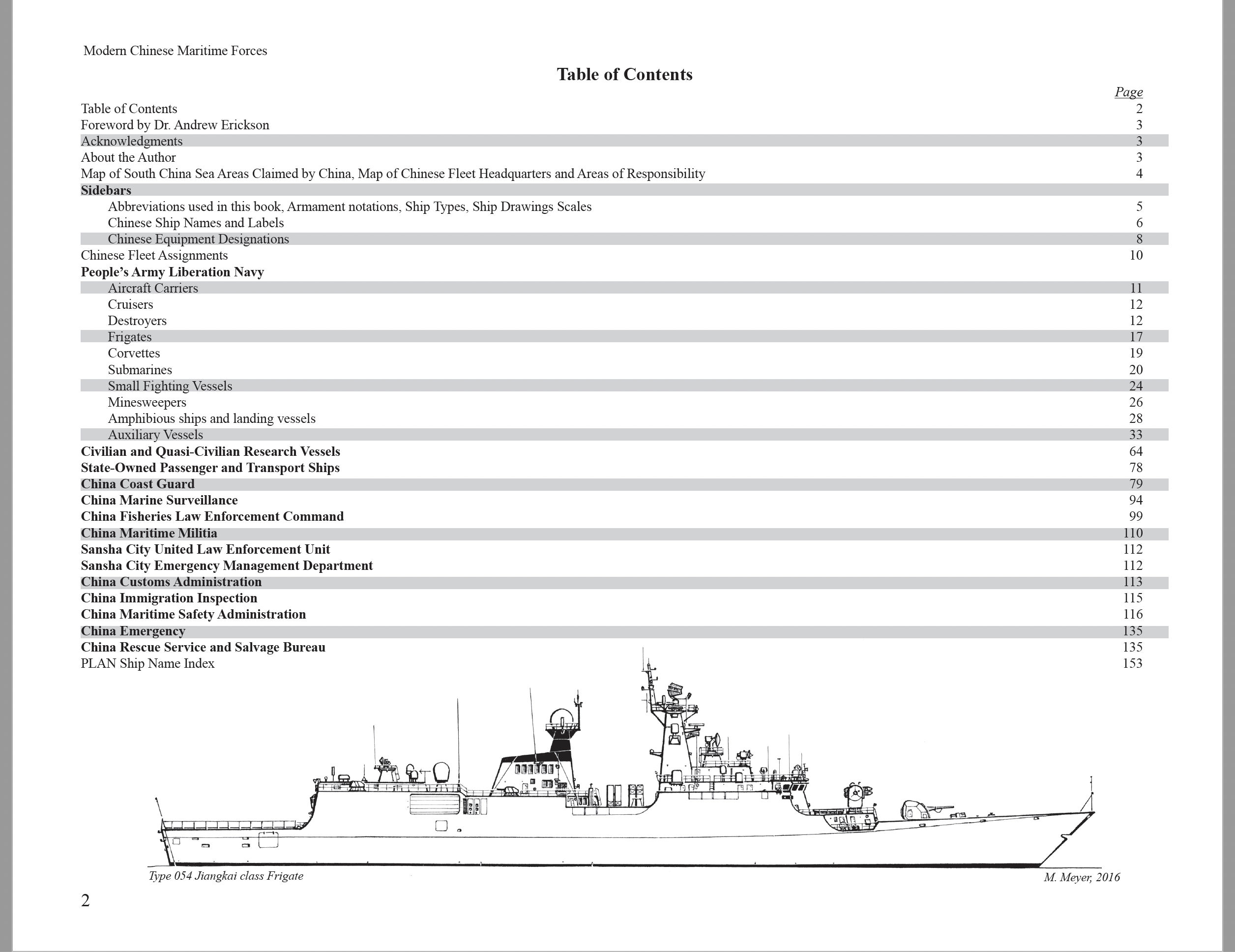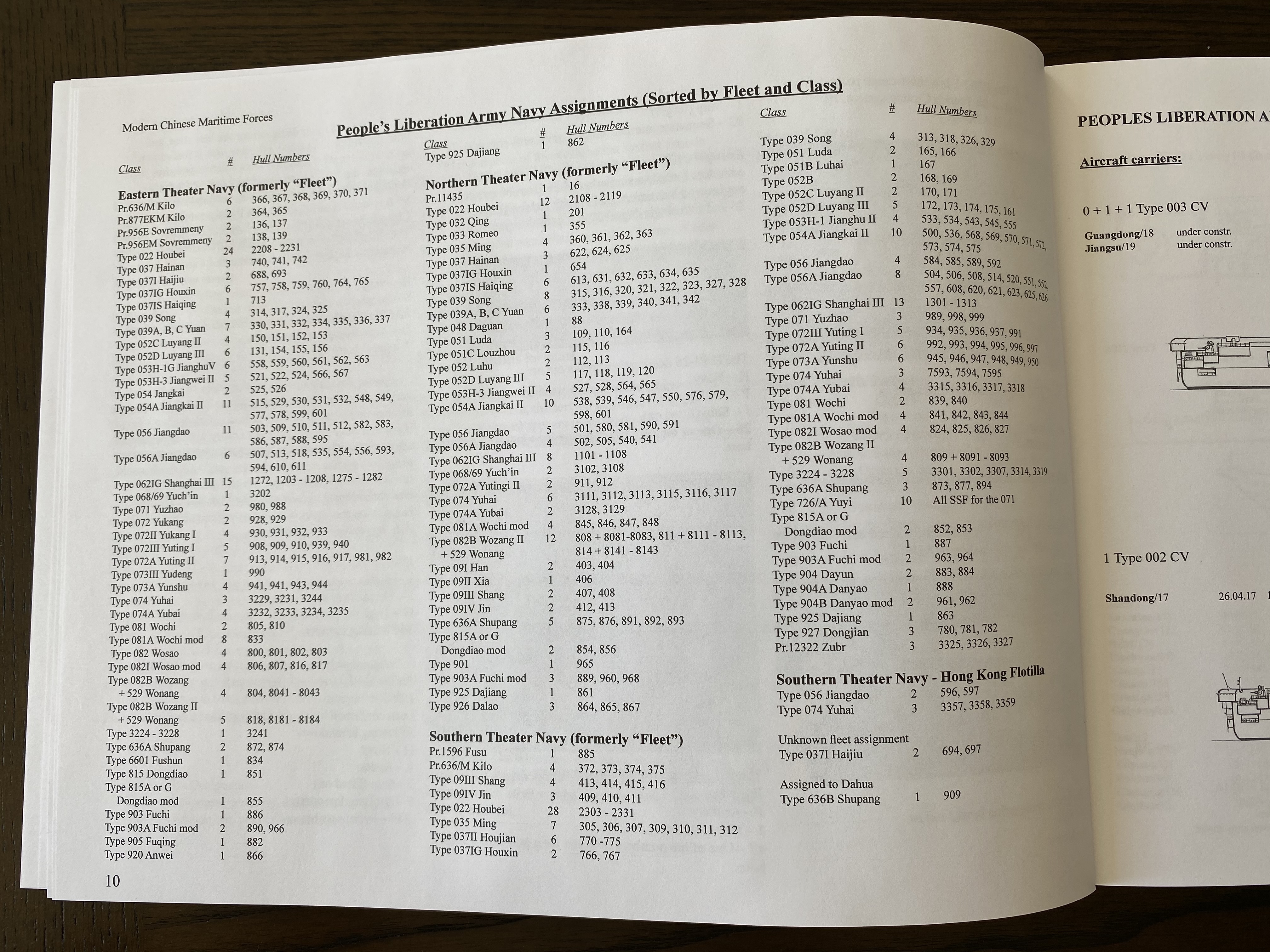Start New Year Right! “Modern Chinese Maritime Forces”—1 January 2023 ed.—Order of Battle for World’s Largest Navy, Coast Guard & Maritime Militia by Ship #s
2023 looks to be a rough year. Heavy seas ahead… Start it right by consulting the latest edition of Modern Chinese Maritime Forces—just released today!
This is the most comprehensive unclassified, open source PRC sea forces order of battle, data, and ship drawings available anywhere. It tracks the world’s most-numerous Navy, Coast Guard, and Maritime Militia vessels in unrivaled detail. Even just flipping through this volume for a minute reveals the staggering scope and extent of Beijing’s sea power across the waterfront today. I simply could not be more honored to contribute the Foreword!
Manfred Meyer (edited by Larry Bond and Chris Carlson), Modern Chinese Maritime Forces (Admiralty Trilogy Group, 1 January 2023).
- “A compilation of ships and boats of the Chinese Navy, Coast Guard, Maritime Militia and other state authorities”
- In terms of ship numbers, each of China’s three sea forces is the world’s largest by a large margin. For the scenarios that most concern the U.S. and its regional allies, these numbers matter greatly.
- This suggests an important conclusion: China’s numerical sea force supremacy and the corresponding need for power projection and presence to counter it effectively demonstrates the need for a substantially-sized U.S. Navy. This book can help inform related deliberations and development. All the more reason to consult this handy compendium today!
- Click here to download sample content.
- Check out the complete nuclear-powered submarine coverage on pp. 20–22!
- Conventionally-powered submarine coverage includes entry on the Type 039C Yuan-class SSP (p. 22)…
- Unique PAFMM ship silhouettes and related information on pp. 109–10! Updated to include Guangdong Province vessels.
- Check out the crane ship coverage on pp. 148–50!
- Ro-Ro ferries are featured on p. 152.
- You can order a copy here.
- The .pdf version is a living document, updated quarterly (1 January, 1 April, 1 July, 1 October of each year) with new drawings, commissionings, decommissionings, and other ship data as it becomes available.
- Single purchase includes access to future periodic updates of the volume.
RELATED PUBLICATIONS
In addition to Modern Chinese Maritime Forces, the Admiralty Trilogy Group also offers a dedicated supplement for Harpoon V regarding PLA Navy, PLA Air Force, China Coast Guard ships and aircraft as well as missiles/weapons and sensors. It is designed as a sourcebook for the game, but can also be used as an unparalleled reference (offering unrivaled coverage from 1955 to the present).
- Larry Bond, Chris Carlson, and Peter Grining, eds., China’s Navy: Ships and Aircraft of the People’s Republic of China, 1955 – 2021 (Admiralty Trilogy Group, 1 October 2021).
Admiralty Trilogy Group similarly offers dedicated sourcebooks for Harpoon V on Russia’s Navy and Military Aircraft, respectively, which likewise double as unique general references.
- Larry Bond, Chris Carlson, and Peter Grining, eds., Russia’s Navy: The Soviet and Russian Navy, 1955 – Present Day (Admiralty Trilogy Group, June 2021).
- Larry Bond, Chris Carlson, and Peter Grining, eds., Russia’s Aircraft: Russian Military Aircraft, 1955 – Present Day (Admiralty Trilogy Group, June 2021).
The Admiralty Trilogy Group (ATG) is pleased to announce that in addition to publishing games supporting its tactical naval game system, the Admiralty Trilogy, it has released its first nonfiction book. Click here to read the announcement.
Modern Chinese Maritime Forces, by Manfred Meyer, a noted artist and illustrator, provides up-to-the minute information on Chinese sea power. It lists all Chinese state vessels – not just the People’s Liberation Army Navy, but the Coast Guard, China Maritime Surveillance, China Fisheries law Enforcement Command, and many other state-sponsored agencies that carry out China’s policies at sea.
Over 570 drawings show everything from aircraft carriers to buoy tenders, accompanied by detailed information on their characteristics. Additional supporting material includes theater navy assignments for individual ships as well as descriptions of the Chinese systems for hull numbers and equipment designations. This compact book has the most complete unclassified information on Chinese state-owned vessels available anywhere.
I was honored to contribute a Foreword, in which I write: “Today, China’s maritime forces have the most ships of any nation. This pathbreaking book documents their force structure in unprecedented detail.”
Modern Chinese Naval Forces is available as either a searchable .pdf or a softcover 139-page book. Both can be bought as a bundle for a reduced price.
- Andrew S. Erickson, “Foreword,” in Manfred Meyer (edited by Larry Bond and Chris Carlson), Modern Chinese Maritime Forces (Admiralty Trilogy Group, 2023), 3.
FOREWORD
Ships are the ultimate embodiment of maritime strategy. Today, China’s maritime forces have the most ships of any nation. This pathbreaking book documents their force structure in unprecedented detail, making it an invaluable reference for all who seek to understand Beijing’s seaward surge and its manifold implications.
While remaining shackled to undeniable geostrategic realities on land, and hemmed in by “island chains” surrounding peripheral seas, China has gone to sea dramatically in both commercial and military dimensions. It is arguably the first continental power in two millennia to become a successful hybrid land-sea power and keep that sea change on course sustainably. Rather than operate freely on exterior lines like such geographically advantaged sea powers as the United States, the United Kingdom, and Japan, China must radiate sea power from interior lines in a way that currently prioritizes the assertion of increasing control over its disputed sovereignty claims in the Yellow, East, and South China Seas while seeking growing influence across the Indo-Pacific and nascent global access and presence.
To pursue these radiating ripples of maritime interests and activities, China draws on three sea forces, each the maritime component of one of its three armed forces: the (1) People’s Liberation Army Navy (PLAN), (2) China Coast Guard (CCG), and (3) People’s Armed Forces Maritime Militia (PAFMM). Each Chinese sea force has the world’s most ships in its category. The volume covers in great depth China’s first and second sea forces, the PLAN and CCG, which contain the vast majority of its purpose-built government vessels. This fully-updated new edition has been revised to also include key PAFMM vessels. In doing so, it uniquely elucidates the three-pronged trident of Bejiing’s maritime force structure.
China’s ship numbers matter, greatly. First, China increasingly enjoys both quantity and quality at sea. In recent years China has overcome Cold War shipbuilding that produced crude Soviet-style hulks. The PLAN, naturally China’s most advanced sea force technologically, has most dramatically replaced backward rustbuckets with increasing numbers of sophisticated platforms. But the CCG and PAFMM are also modernizing significantly. Of China’s three sea forces, its coast guard has grown the most rapidly in numbers and enjoys the greatest global numerical superiority.
China’s shipbuilding juggernaut, powered by what until very recently was indisputably the world’s fastest-growing multi-trillion-dollar economy, has sustained rapid modernization of all three sea forces even as numbers of modern vessels grow substantially. China’s commercial shipbuilding juggernaut subsidizes overhead costs for construction of all three sea forces’ vessels, an impossibility for America’s military-focused shipbuilding industry. CCG construction is thus both economical and efficient. Commercial off-the-shelf drivetrains and electronics, together with a lack of complex combat systems and weapons, facilitate rapid assembly with multiple units constructed simultaneously.
Second, when it comes to deployment, even the most advanced ship simply cannot be in more than one place at once. Numbers matter significantly when it comes to maintaining presence and influence in vital seas. This is particularly true regarding the growing Sino-American strategic competition where the United States is playing a distant away game. U.S. Coast Guard cutters are focused near American waters, far from any international disputes, while the U.S. Navy is dispersed around the world, with many forces separated from maritime East Asia by responsibilities, geography, and time. Meanwhile, all three major Chinese sea forces remain focused first and foremost on the contested “Near Seas” (the Yellow, East, and South China Seas) and their immediate approaches, close to China’s homeland bases, land-based air and missile coverage, and supply lines.
For all these reasons, a complete unclassified order of battle for China’s Navy, Coast Guard, and Maritime Militia is long overdue. This pioneering volume finally fills that vital void. I commend it to everyone seeking to understand how China is making such great waves on the world’s oceans, and what course it may take in coming years.
Andrew S. Erickson
China Maritime Studies Institute
Newport, Rhode Island
REVIEWS
“This is a phenomenally thorough project, and I suspect it is both more complete and up to date than anything available to our armed forces at a classified or unclassified level. Herr Meyer’s meticulous research and superb drawing skills have produced a reference resource of unparalleled usefulness for anyone needing a handy reference for China’s vast naval and paranaval forces.”
– A.D. Baker III, former editor of Combat Fleets of the World
“I think it is for the first time that such a nearly complete overview of the Chinese maritime services has been made available to the public. The Chinese navy has risen in twenty years from a regional outdated navy to one of the global players which cannot be overlooked by the other world and regional powers.”
– Werner Globke, editor of Weyer’s Warships
“This is a badly-needed book: an accessible, compact guide to the ships of the Chinese navy and its related paramilitary services. All of the ships are shown in very clear scaled drawings, which give a good sense of size and configuration. No other guide of this type exists. That makes this quite possibly the only good reference to the Chinese fleets. No one concerned with current naval affairs can afford to miss it.”
– Dr. Norman Friedman, technical naval author
“I devoured this book. This is perhaps the most important and most comprehensive technical naval analysis book to appear in a generation. With the advent of Cold War II and the announced return to great power competition between the United States and the People’s Republic of China, this book should be on the bookshelf of every serious U.S. Navy officer and naval analyst. It will be the standard reference.”
– Captain Jerry Hendrix, USN (ret.), Center for a New American Security




























































